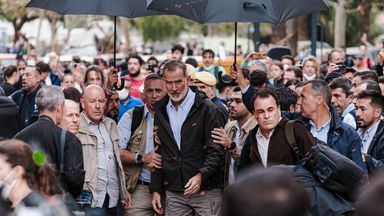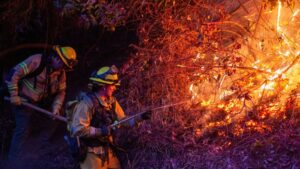Angry crowds hurl mud and insults at King of Spain as he visits town devastated by floods
King Felipe faced protests as he visited one of the towns worst-affected by the flash floods which killed more than 200 people in eastern and southern Spain earlier this week.

A crowd of angry survivors have hurled mud and insults at Spain’s King Felipe during a visit to one of the worst flood-hit towns.
The King and his wife Queen Letizia, along with Prime Minister Pedro Sanchez, were touring devastated Paiporta, just outside Valencia, as the public rage over the management of the crisis came to a boil on Sunday.
The overall number of deaths from the devastating floods which hit the south and east of Spain on Tuesday and Wednesday has gone up to 217, with most of them being reported in the Valencia region.
Paiporta was one of the hardest-hit areas where more than 60 people died and thousands of lives were shattered.
Pictures of the King’s visit to the town show his face covered in flecks of mud, but after being forced to seek protection, he seemed to remain calm as he proceeded to talk to residents.
However, Mr Sanchez was evacuated from the scene as the official contingent started to walk the mud-covered streets, according to Spanish broadcaster RTVE.
Police on horseback were forced to step in at one time and push back a crowd of several dozen people.
“Get out! Get out!” and “Killers!” rang out among other insults.
“They knew it, they knew it, and yet they did nothing,” one young man shouted at the King while waving a finger in his face.
Bodyguards opened umbrellas to protect the royal visitors and officials as protesters hurled mud at them.
Read more:
Divers search for bodies in underground car park in Spain
Anger at response to Spain floods grows
One young woman swatted a bodyguard with a long pole.
However, as the King insisted on trying to talk to residents during his visit, one person appeared to weep on his shoulder.
He spoke to several people, patting two young men on their backs and sharing a quick embrace, with mud stains on his black raincoat.
According to a journalist for Spanish broadcaster RTVE, one woman wept and told the King she did not have food and nappies, while another person said: “Don’t abandon us.”
The Queen, with small dollops of mud on her hands and arms, also spoke to some women.
“We don’t have any water,” one told her.
But after about half an hour of tension, the monarch and the rest of the delegation got into official cars and left with a mounted police escort.
One woman smacked an official car with an umbrella, and another kicked it, before it sped off.
It was an unprecedented incident for a royal house that takes great care to craft an image of a monarch who is liked by the nation.
Shock leads to anger
In addition to the more than 200 deaths, thousands have had their homes destroyed by the wall of water and mud.
Dozens of people were still unaccounted for in the area hit by the floods today, while some 3,000 households still had no electricity, officials said.
The floods engulfed streets and lower floors of buildings, and swept away cars and bits of masonry in tides of mud.
Indignation at the management of Spain’s worst natural disaster in living memory started after the initial shock wore off.
The floods had already started filling Paiporta with crushing waves when regional officials issued an alert to mobile phones that sounded two hours too late.
And more anger has been fuelled by the inability of officials to respond quickly in the aftermath.

Keep up with all the latest news from the UK and around the world by following Sky News
Most of the clean-up of the layers and layers of mud and debris that has invaded countless homes has been carried out by residents and thousands of volunteers.
Thousands of additional troops and police joined the disaster relief effort over the weekend in the largest such peacetime operation in Spain.
The tragedy is already Europe’s worst flood-related disaster in a single country since 1967 when at least some 500 people died in Portugal.
Scientists say extreme weather events are becoming more frequent in Europe, and elsewhere, due to climate change.


